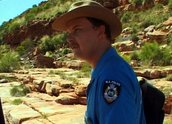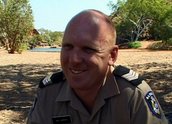


Kimberley Cops (2001)
Synopsis
This documentary series follows the lives of policemen serving in the Kimberley, in the remote north of Western Australia. The officers serve the vast area, dealing with lost tourists, rogue crocodiles, Aboriginal children and community liaison.
Curator’s notes
The series slowly develops into fascinating viewing as the personalities of the officers emerge. The situations that they encounter are vastly different from city police. The laconic friendly policemen are reminiscent of a past Australia and the end result is delightful viewing.
Secondary curator’s notes
by Sophia SambonoThis four-part documentary series is a glowing representation of the police force based in the remote Kimberley region. Filmed over a year it has a strong focus on the tyranny of distance, on the environment and the geographical constraints the police encounter.
There is a heavy emphasis on the dangers of life in the region and on the harsh realities of life in the outback. Throughout the series these issues are a constant backdrop to stories of rogue crocodiles, tipped cattle trucks and search-and-rescue operations for lost tourists, backpackers and fishermen.
At times it seems to be a bit like a public relations ad for the police as the series reassures us that the police really are good people and are trying to improve their dealings with the Aboriginal people of the area.
However, the representation of Aboriginal people in the documentary is shallow and simplistic. The Aboriginal people featured are seen as trackers or troublemakers. Commentary is mainly given by the white cops or the narrator with no real opportunity for Indigenous self-representation, despite the presence of three Indigenous liaison officers. They are seen throughout the series but none of them are granted a feature story. The patronising treatment is evident in shots of Aboriginal men 'sleeping off a session on the grog’ after being 'locked up for their own safety’.
There is a conspicuous absence of unfavourable interaction between the police and Aboriginal people. There is only one scene involving conflict over race issues when a cop threatens to call children’s services after a pub patron has their child at the pub and is called racist. In the background a liaison officer attempts to neutralise the situation.
Despite the documentary’s interest in the general harshness of the area it only lightly touches on the poor living conditions of the Indigenous people who form the majority population in most townships. Issues affecting Aboriginal people are mentioned briefly but only as another obstacle for the brave, hardworking police force.
Some officers do seem genuinely interested in the people, their wellbeing and their future. They want to change the future by changing the kids’ view of, and relationship with, the police through mutual respect. This is evident in interactions of the Halls Creek officers on their visit to Balgo (see clip two), particularly with Sergeant Neil Gordon. Gordon is involved in a type of kinship care arrangement after being asked by the grandmother of a young man to 'bring him up the rest of the way’ (see clip three).




